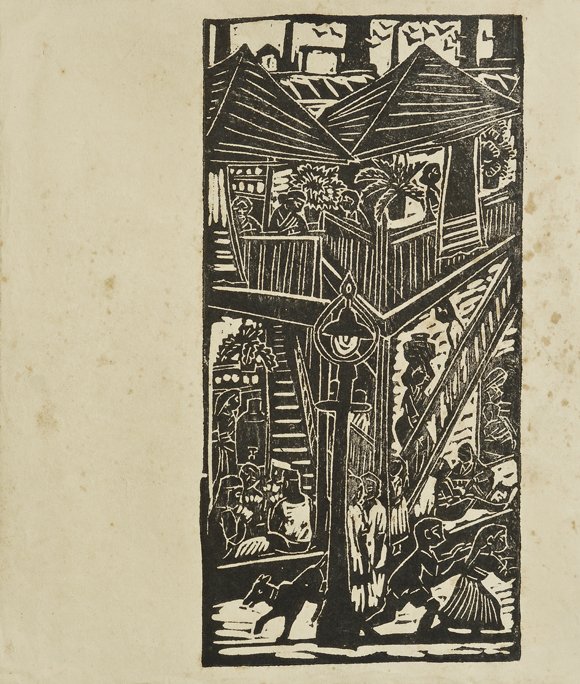
Chittaprosad: Linocuts & Woodcuts
July 23, 2018 – September 15, 2018 at Akar Prakar, Kolkata
Scars of the Bengal famine and death are not the sole elements in Chittaprosad’s work; one must recall that he had expressed his antagonism against the food grain hoarders besides celebrating the many joys of life in his works. His work is a reflection of his free spirit, unburdened by normative values.
Chittaprosad’s works are especially powerful. He was a very talented man, brimming with zest for life, free of all shackles. His way of life, his passionate works of art speak volumes about unfettered freedom. Would he have painted the themes of ‘Ramayana’ and ‘Mahabharata’, nature, or the bright-eyed children at puppet shows if he believed otherwise? He had never attempted to constrict the various human natures or enforce uniformity of any kind. He loved humanity with all its motley differences.
In a manner of speaking, an undeniable degree of cunning may have tiptoed its way into the arts in the present day. I have often asked myself, how is it possible for a person who can move their listeners to tears with their songs, to be as twisted. It may appear that they have mastered the art of vocal music, but their art has no association with their life. When I view a painting, I try to see if it embodies and/or conveys any perceived truth or value. Precisely what is ‘truth’ or ‘value’? Has truth or value been spoken from the heart of the artist who has painted the picture? Is their own life related to the painting or to art itself? Is the world that belongs to the art, their own? Or are they a mere intruder in someone else’s realm? Have they reaped someone else’s harvest? Or have they produced a crop? Then follows the question of skill. Have they been able to manage the technique adequately in their works? If their art fails to come alive, it signifies that the skill must be missing. Taking ‘truth’ and ‘value’ into consideration, Chittaprosad had been victorious. His works reveal a rare marriage of art and life.
There are quite a few dissenting artists, who paint images of protests but unfortunately they cannot give up on their privileges. This is where Chittaprosad stands apart from the so-called “Marxists”. It may be worthwhile to note, in spite of his dedication to Marxist ideology he did not confine himself to Marxist orthodoxy. What is protest? It manifests itself through the power of resistance; firmness of the mind, integrity of character. I believe it is ingrained in a person right from their childhood. Chittaprosad held firm onto his ideologies and he was a man of great character. He lived an exceptional life on his own terms. Just like Ramkinkar, who had rustic roots and remained true to it, Chittaprosad remained steadfast in his vision and choices. He achieved a rare blend of life and art, as is visible in this selection of works.
Ganesh Haloi
Chittoprasad | Untitled | Linocut on paper | 11.5 x 9 in
Chittoprasad | Untitled | Linocut on paper | 12 x 9 in
Chittoprasad | Untitled | Linocut on paper | 12.75 x 9.75 in
Chittoprasad | Untitled | Linocut on paper | 12 x 13.75 in
Chittoprasad | Feeding the cow & her calf | Linocut and serigraphy on paper | 7 x 5.5 in | 1963
Chittoprasad | Book cover | Linocut and etching on paper | 9.5 x 8 in
Chittoprasad | Untitled | Colour linocut on paper | 6 x 9 in
Chittoprasad | Untitled | Woodcut print | 11.5 x 6 in
Chittoprasad | Untitled | Woodcut print | 10 x 13.5 in
Chittoprasad | Untitled | Woodcut print | 9.5 x 11 in
Chittoprasad | Untitled | Woodcut print | 10.75 x 4.5 in
Chittoprasad | Untitled | Linocut on paper | 9.5 x 11.75 in
Chittoprasad | Untitled | Linocut on paper | 10.5 x 9.75 in
Chittoprasad | Untitled | Linocut on paper | 13.5 x 8.75 in | 1952
Chittoprasad | Untitled | Linocut on paper | 7.75 x 10.25 in
Chittoprasad | Untitled | Linocut on paper | 8.5 x 6 in
About Chittaprosad Bhattacharya (1915 – 1978)
Denied admission by Government School of Art, Kolkata and Kala Bhavan, Santiniketan, Chittaprosad, went on to become a self-taught artist maturing into one of the master Modern artists of India who documented his observations collected from the villages of Bengal. His work tells a tale about human suffering and revolution; a genre of art of the 1940s that questions the fascist regime. The idyllic pastures he visited were far from romantic— Behula’s banks were flooded, homes were massacred by the storm, paddy-stacks were spoiled, followed by the famine, which forced the villagers to loan from the government and buy crops at an inflated rate. He dreamed about a country free from diseases, where the people are well-fed and employed. His uninhibited caricatures and sketches depicting the affliction caused by the Bengal famine (1943) were looked upon as brutally honest works which could destroy the reputation of the British Raj.
In the mid 1940s, He was associated with Indian People’s Theatre Association (I.P.T.A) and took a keen interest in Javanese masks and puppets as evident in various prints. Later, he became a migrant in Bombay giving form to the transition as expressions in his work. Not only did he produce prints depicting children whose world is devoid of fairy tales, but also gave up his upper-caste, brahmin surname—Bhattacharyya as a mark of protest against the bourgeois.
Chittaprosad first exhibited in Prague's National Gallery. Amongst his noted works are the posters and paintings of the Naval Mutiny in Bombay (1946). He even joined the World Peace Movement.



















